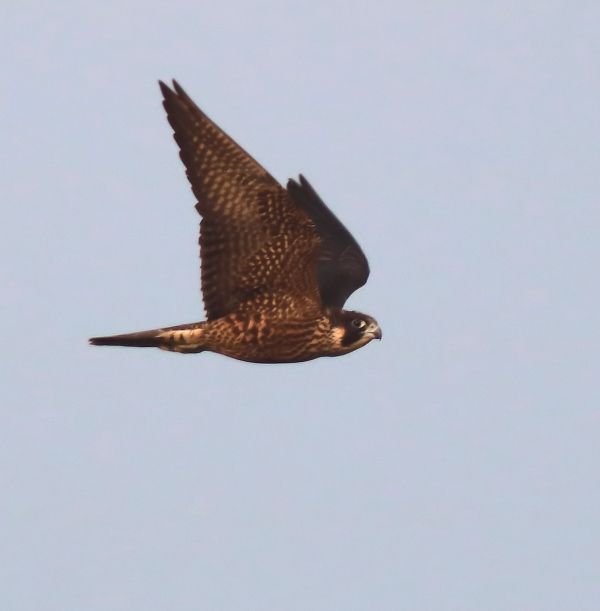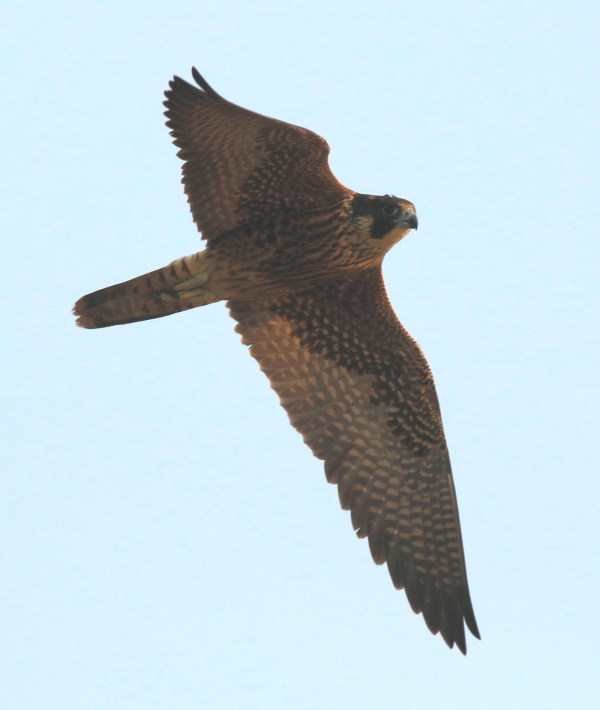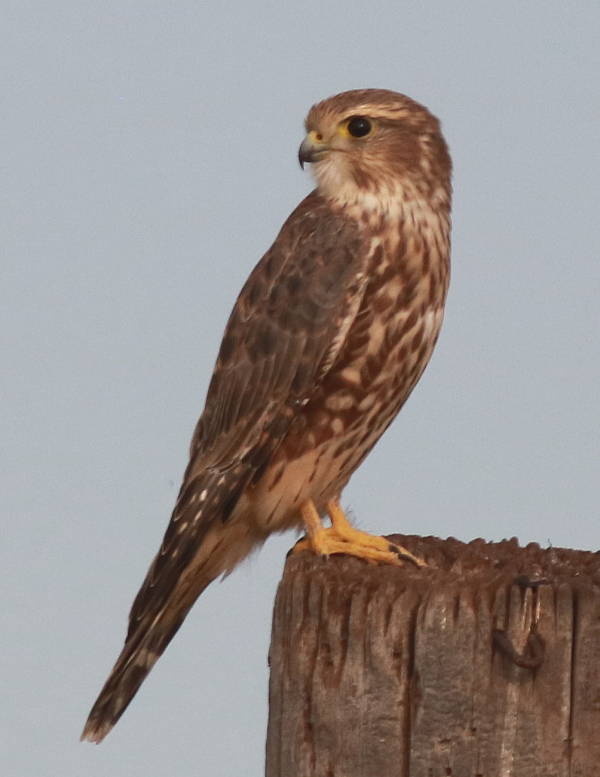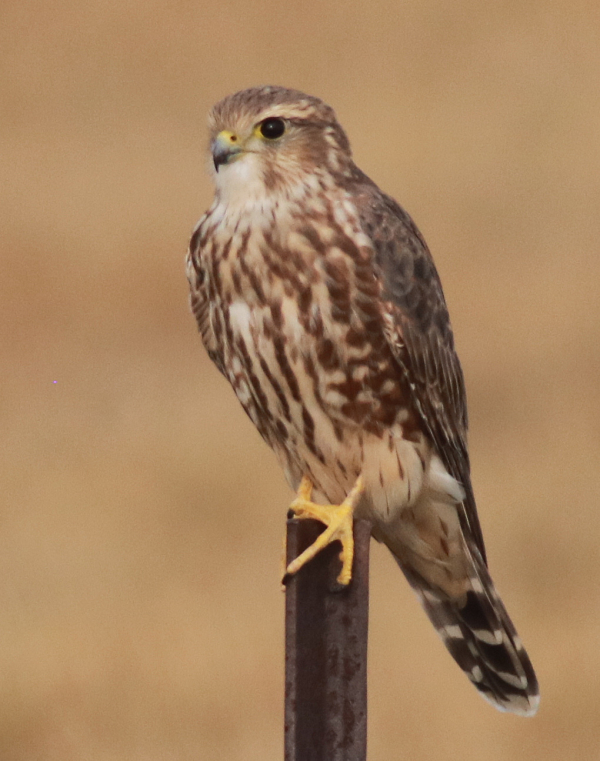Although extremely rare, mid- to late-September is prime time for falcon sightings in the Northern Great Plains. Peregrines, Merlins, Prairie Falcons, and definitely American Kestrels are on the move. A single Peregrine or Prairie can define the entire migration season for the species some years. Merlins are spotty but more likely over a longer six week period. Kestrels are widely spread, but at times I see two at one time, suggesting a pair or nest mates, or a social interest of some kind between them. As hard as it is to see a falcon during its momentary migration stop is one thing, photographing it is infinitely harder.

Variable hazy conditions during a spectacular photo opportunity with a young Peregrine Falcon compromised the quality of this photo, especially the sharpness of the bird in classic falcon flight.
|
During migration stops, when Peregrines take flight they tend to be gone, flying out of sight rather than moving to the next perch down the road. Prairies are pretty similar, so you need to be dialed in when you approach one of the bigger falcons with the intent of photographing it. Too often though we get so excited that all caution goes out the window and we rush to action before the window of opportunity suddenly closes into a distant falcon flight. That’s understandable though; a falcon is a formidable bird and each photo holds the highest esteem in our photo files – for some of us at least.
Then too, like any bird photo opportunity, the weather and lighting conditions are factors in getting a good photo during a falcon encounter. Now, add to that environmental conditions; specifically, smoke haze. The first week of the western wildfire emergencies, the expanse of smoke was mostly blown west over the Pacific Ocean, but the second week the smoke was pushed eastward to the Rockies and beyond. I first noticed the haze in my area of the northern Great Plains on Sunday, September 13, when it was supposed to be a sunny day, but “cloud cover” prevailed throughout the day. It didn’t register with me until the next day that the “cloudy” conditions were actually a thick smoke haze. And the effect of the haze became all too apparent during a period when the sun broke through and a Peregrine Falcon miraculously appeared and presented itself for photography.
Just three miles north of my office I was caught off-guard when a Peregrine Falcon flew low and slow along a little ridge next to the road. I pulled over and the young tundra Peregrine circled to fly just north of me, headed east – allowing me to photograph it as it turned southeast with the sun at my back. There was plenty of haze between me and the sun though, and I hoped the effect of the smoke particles would be minimized as I photographed its swift flight (the first photo illustrating this article).

Only a few moments earlier the sunlight was brighter and would have better illuminated this image, taken when the Peregrine doubled back and flew almost directly overhead. Hazy conditions created subdued lighting similar to those experienced under a cloudy sky.
|
Unfortunately, the resulting photograph shows the sunlight was affected by the smoke haze in much the same way as if there was similar cloud cover – not surprising I guess, but it also added a little amber glow. Disappointing, but not enough to dampen the thrill of the opportunity to photograph this remarkable falcon in action.
This falcon photo episode was special, for although the young Peregrine flew beyond photo range for a couple moments, it actually circled back to fly toward me, passing so close overhead that its wings did not fit within my photo frame. Unfortunately, the haze had increased a bit more since the falcon made its first pass, so I was even more concerned for the effect on the photo results, but that feeling was fleeting considering I had just followed the advance of a dynamic Peregrine through my camera lens.
The best of that series of photos is the second photo used to illustrate this article. The result is obviously disappointing; it rivals a photo taken under cloudy conditions, but it is also rewarding to see that all the other photo elements are good. If there had been normal 5:00pm sunshine, I would have had some epic photos to share with you. Instead, I’m sharing what’s wrong with them; but let’s chalk that up to practice, and experience, and the thrill of the moment rather than shortcomings of the resulting image.
Beyond the Haze
I certainly sympathize in a huge way for the people most affected wildfires, especially in Oregon, California, Washington, and Colorado. Certainly, other parts of the western United States are much more affected by the sight, smell, and health hazards of wildfire smoke, but I thought I would try to offer some suggestions for beating the effects of the smoke haze on photography during days when conditions improve, but we are still affected by this environmental and human crisis.
Merlin’s Falcon

Two days later, with only a hint of smoke haze in the sky, photos of a Merlin show much better detail, color, and sharpness.
|
By last Wednesday, September 16th, the haze had improved as I drove due west cross-country to the Missouri River, so I had high hopes of finding another falcon or falcons to photograph. With several American Kestrels and a distant Peregrine Falcon already sighted as I approached Bismarck, I knew I had a fine potential for photographing a Merlin that I spied as I drove past its perch on the edge of an open prairie. It didn’t seem like the haze was a factor during the ensuing photo session, during which the trusting Merlin permitted me to photograph it in a number of poses.
Two of the resulting photos illustrate this article, and they are definitely big improvements on the Peregrine photos, showing better details and color. You can tell that the sun was a shade brighter for the second photo, but if you take a close look in the eye of the Merlin, you can see the reflection of the sun in the pupil is dull, an indication of the quality of the light. Even so, both Merlin photos and poses are pleasing, and if you are interested in the full story of this Merlin encounter and the rest of the falcons I observed that afternoon, you can refer to my Editor Afield article in this issue.
Variations of Light
The smoke haze filters the light in a variety of ways, in some cases creating the equivalent of cloudy conditions; other times the haze reduces the full force of the sun, and sometimes the haze creates a bit of a yellow cast on the light and landscape. So what do we need to do to address the effects of the smoke haze in coming days and weeks while these conditions persist?
Quality sunlight is paramount for taking the best quality photos, so on the haziest days, when conditions are similar to a cloudy day, I usually opt for other activities instead of bird photography. Birding with a binocular and spotting scope are options, but sunlight provides the colors, sharpness, and quality for the best bird photographs. When the haze fades and the sunlight breaks through, we’re back in business.
One thing to keep in mind is that the haze dulls the light a bit, usually a bit more than we think. There’s not much we can do about that, but it’s worth trying to open your aperture a bit by changing from a usual f8 to an f6, for example. This may highlight the details of your subject more, and it provides a corresponding faster shutter speed, which will help stop action better. Another option might be to give the ISO dial another click; for me that would mean dialing from ISO 400 to ISO 800. That option will improve the brightness of the light in your photos too; just remember to change it back when conditions permit.
Timing Twists

Although this is the same Merlin as illustrated in the other photo, it looks like a different bird; partly due to change of background and perch after it repositioned, as well as its forward position. A close look in the eye of the Merlin reveals the reflection of the sun in the pupil is dull, an indication of the quality of the light, although the slightly subdued light may actually be a plus for this image.
|
Since the smoke haze is primarily coming from the west, smoke particles are most concentrated in that direction. That means that as the sun begins to set in the west, its light intensity is affected much more than normal. In response, I have been beginning and ending my afternoon photo sessions earlier. Optimum photo light was from 4:00pm to 7:00, but under recent lightly hazy conditions, my prime time is 3:00 to 6:00pm.
Moving my photo period earlier in the afternoon is a better option now because the sun is being positioned ever-farther south in the sky as fall advances, providing a fairly good lighting angle later in the morning and earlier in the afternoon. Eventually, this advance of the sun into the southern sky will provide a good lighting angle throughout the day, especially during winter months.
One other thing that can be helpful when trying to get the most out of photos you take during slightly hazy conditions is to try to lighten or brighten photos a bit in your digital dark room – your computer, using your photo editing software. Sometimes it helps, sometimes not enough, but when you have a photo of a rare falcon that needs some help, you do the best you can and hope for the best possible image.
We all hope the wildfires end and the smoke clears soon, and we wish all the best for people affected across the American West! Keep photographing, adjust as you must, and enjoy the fall season. And keep an eye to the sky with the hope for a falcon encounter – good luck!
Article and photographs by Paul Konrad
Share your bird photos and birding experiences at editorstbw2@gmail.com